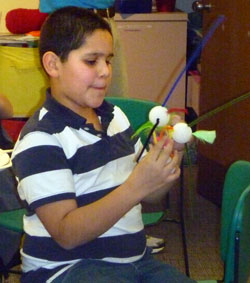This activity introduces students to microbe basics, such as physical characteristics, reproduction, nutrition, and physiology. Students will also learn the basics of biological classification by grouping “microbes” that they create according to appearance.
Objectives
- Students will understand basic microbe concepts
- Students will create their own microbes based on this understanding
- Students will classify organisms by appearance
Materials
- Create a microbe worksheet
- Drawing supplies
- Art supplies to create a 3-D microbe:
- Styrofoam balls
- Pipe cleaners
- Felt
- Feathers
- Yarn
- Paper scraps
- Toothpicks
- Scissors
- Glue
- Whatever else you can think of!
Procedure
- Have students brainstorm what they know about microbes; go over their responses as a group, focusing discussion on physical characteristics of microbes.
- Assign students the task of creating their own microbe using supplies provides. Students should consider the following (also on Create a Microbe Worksheet):
Does your microbe...
- have a way of taking in food/energy? Can it make it’s own food? If so color it green; if not, then what does it eat? (Dead/decaying material or waste? Fresh food like you? Or does it absorb nutrients from what it lives on?)
- have a way of reproducing or passing on it’s DNA? (Does in reproduce sexually, asexually, or does it transfer it’s DNA into other organisms and make them do the work?)
- have some kind of body organization?
- Move around? If so how does it move around?
- Stay put or attach itself to something?
- One large cell with parts inside?
- One large cell with specialized compartments (organelles) inside that perform functions similar to us?
- Several smaller cells?
- How big is it 1 to 20 microns?
Take it to the next level (optional)
One way we classify microbes is by how they look. Have students devise a microbe classification system based on common physical characteristics. Divide students into groups if necessary, but make sure enough microbes are in each group so that there are enough similarities/differences to compare. Students should place microbes with similar characteristics into groups, and then create a table listing each group with corresponding common traits. If you have time, students can sub-divide groups, then name their microbe "species" using binomial nomenclature. Discuss as a class the classification schemes that the students created, and relate to phylogenic classification system that scientists currently use.
Hint
You might want to limit the amount of art supplies to limit the “species”/groups of microbes that students create. This will simplify classification.
Discussion questions
Why is it important to classify organisms?
Could you have classified your microbes differently? If so, how?
In addition to physical traits, how else do scientists classify living organisms?
Lesson Resources
National Science Education Standards
K-12 Unifying Concepts and Processes
- Systems, order, and organization
9-12 C Life Science
- The cell
- Biological evolution